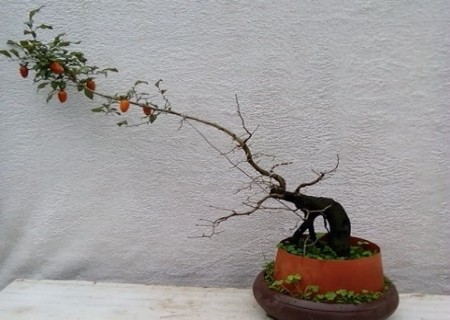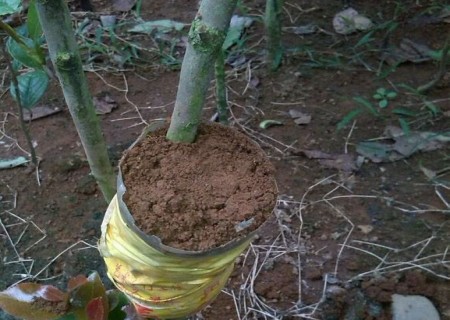Graphic method of High pressure Propagation of Prunus mume
Some novice flower friends do not understand what is high-pressure reproduction, high-pressure reproduction is a kind of striping propagation, striping is divided into high pressure and low pressure, low-pressure reproduction is simply to press the branches directly to the ground, as shown in figure 1. On the other hand, the high pressure (figure 2) is due to the fact that some plant branches are not easy to bend, which are cut or peeled around and propagated in sand (other media).

Let's talk about the concept of high-pressure reproduction, and then look at specific cases:
High pressure is also called air crimping. Created by China, also known as Chinese striping, suitable for tall or not easy to bend plants, mostly used in valuable tree species (camellia, sweet-scented osmanthus, longan, litchi, pistachio, etc.). Select 1-3-year-old branches, peel 2-4 cm around, scrape off the cambium or longitudinally carve into a wound, wrap the cut with plastic sheeting, opposite bamboo tubes and earthen pots, tightly bind and fix it, fill it with moss or fertile soil, often water and moisturize, and cut off into new plants after rooting.
Let's take a look at the specific case of high-pressure reproduction of triangular plum:
Paper towels are used in the case. in practice, plastic bags, disposable cups and other media can be filled with soil or other media. Flower friends do not have to stick to the case. After all, the case is only a method of high-pressure propagation of triangular plum. The purpose of our display is to provide process reference for flower friends.
1. Girdling, the width is about 0.5-1cm. Scrape off the branch cambium.
2. Rooting powder solution can be applied to the wound.
3. Paper towels are wrapped on the wound, fastened, and then wrapped in plastic wrap (using paper towels is only a few ways, most of which are wrapped in soil, and then wrapped in plastic bags. See the second picture below, a sample of high-pressure reproduction of rose).
4. Pour water into the tissue and soak it thoroughly. Replenish the paper towels as the case may be.
5. Paper towels are wrapped with paper to block the light.
6. Take root in a month or so, cut off the branches and put on the pot with paper towels to slow down the seedlings.
High-altitude striping propagation (referred to as high-pressure propagation) is a common breeding method in the cultivation of triangular plum. Friends in the north can carry out high pressure regardless of season when they have heating, while friends in the south can start high pressure after late April.
High-pressure propagation has several advantages: first, the survival rate is high, all the branches that come out of the root system under high pressure, cut off, as long as the root system is not hurt, transplant into the pot, can survive 100%. Second, there is no need to slow down the seedlings. After transplanting, the roots spread out and the leaves basically do not wither and sag when they are placed in a cool place for a few days. The third is easy to shape, large branches under high pressure, cultivated in a new basin, immediately is a sturdy and beautiful potted flower. If you trim it a little bit, it will have the meaning of bonsai.
The specific method is very simple: cut 0.3 cm wide two inches above the bifurcation between the branch and the mother plant, clean the epidermis to the cambium, wrap the rich, loose and moist soil in a plastic bag, tie it tightly at both ends, and the soil is dry midway. you can use a waste syringe to inject water, wrapped in plastic bags, generally not easy to lose water, and can not be injected with water. After more than a month, you can see that a lot of roots (pictured below) can be cut off and transplanted. The following are the two processes of high-pressure survival and transplanting. Many experiments show that the results are very good, and the mature technology is worth popularizing.
A big red two trunk, with a small trunk for high pressure, a month later, a lot of roots can be seen, but also very strong, should be separated from the mother plant.
What it looks like when the picture above is cut out. The very thin plastic bag was punctured by the root system.
Carefully open the plastic bag, the root system is very exuberant, wrap the mud mass, form a root mass, untie the plastic bag is not loose.
Then carefully move to the flowerpot with the pots ready. On the other hand, pile up some soil, let the root mass lean on, and the plant stand so that you can take pictures.
You can free up your hand, cover the root system with soil, compact and pour the root water, which is a good-looking medium-sized potted flower! After that, the root mass is covered with soil, compacted and watered, so that the high-pressure propagation of triangular plum is done!
Time: 2019-06-09 Click:
- Prev

Pruning of persimmon bonsai
Laoya persimmon is a star tree species in the field of potted plants. at the exhibition, it is not only affirmed by potted lovers, but also loved by the general public. In addition to the tree-shaped persimmon, which mainly appreciates the fruit, according to the color, shape, size, sepals and oil dripping spots of the fruit, the Japanese persimmon Association has registered many names.
- Next

High pressure Propagation of Camellia
Camellia is also known as Camellia, Evening Camellia, Datura, Camellia and so on. It can blossom from mid-October to mid-April next year, but most of them blossom from February to April. The colors are red, pink, white and other colors, which are deeply loved by urban and rural residents.
Related
- Fuxing push coffee new agricultural production and marketing class: lack of small-scale processing plants
- Jujube rice field leisure farm deep ploughing Yilan for five years to create a space for organic food and play
- Nongyu Farm-A trial of organic papaya for brave women with advanced technology
- Four points for attention in the prevention and control of diseases and insect pests of edible fungi
- How to add nutrient solution to Edible Fungi
- Is there any good way to control edible fungus mites?
- Open Inoculation Technology of Edible Fungi
- Is there any clever way to use fertilizer for edible fungus in winter?
- What agents are used to kill the pathogens of edible fungi in the mushroom shed?
- Rapid drying of Edible Fungi

